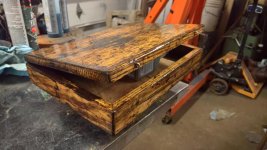


I am also attaching pictures of the reamer inscription and the brand on the bottom of the box.


I did a bit of research about Keystone Reamer and Tool. They were located in Millersburg, Pennsylvania, and per the person that answered the phone at the town hall in Millersburg when I called a few days ago, the company closed about 5 years ago. Evidently it was a long painful death. Some of the employees were hired by Alvord-Polk, also a reamer maker, and what is now Dauphin Precision as the company died. When the end came, the person in the town hall thought that no one bought the name to the company or resumed business elsewhere. I would presume the equipment was sold, but don't know that for sure. All three companies are/were on or close to the Susquehanna River. I found a few other references to the company from the web. There are dozens of reamers of the adjustable type and hand type on Ebay for sale. The others were all on PM asking for information about Keystone R&T. Not much was forth coming.
The bottom of the box did not properly fit into the sides made for it. This was the likely cause for the later damage to the box which I repaired. On the bottom of the box, after sanding away oily wood and grunge, I found a brand stamped or burned into the wood by the box maker. It was at an angle to the box, and way off center. It seemed kind of haphazardly placed. The box was made by American Novelty Works, Herndon, PA. No zip code was given. I remember zip codes coming into being in about the early sixties. It took at least a decade for Zip Codes to come into wide use per my memory. So, I presume the box was made sometime before the mid seventies. I found a few references to American Novelty Works on the web. One was an obituary of a person who evidently worked there shortly before WWII. The other was to something suggesting they were in business in the forties. Herndon, PA is about 21 miles down the Susquehanna River from Millersburg.
Interestingly, the box is made entirely with solid wood, and not a bit of plywood, particle board, masonite, etc. The top and sides are made with a grain pattern similar to oak. The bottom might be pine as it is very soft. The cutouts for the reamers appear to have been routed. The top of the box has two long narrow pieces of oak butt jointed to one another, and the end caps for the top are tongue and groove jointed onto the two long pieces.
Overall not much is known about Keystone Reamer & Tool, at least not much on the web. If anyone knows anything, post away!
Regarding my reamers, some cleaned up and look perfect. Some have signs of use / abuse, such as minor chips on the long straight cutting surfaces, galling on the chucking surfaces from slippage, moderate rust pitting on the chucking surfaces, and rounding on the wrench gripping surfaces, but all are still probably usable. My questions are:
1) What is the roughness of the metal between the cutting surfaces, which does not look like wear to me. Is that common on reamers at the time of manufacture, or is it a sign of poor workmanship, possibly related to company financial distress?
2) What is the tenacious black stuff stuck between the cutting surfaces? It is affected by acetone and WD40, but only with lots of Q-Tips and time spent scrubbing and soaking. How do I get this black crust off?
3) Should I stone off the dents in the reamer without altering the diameter, or leave well enough alone?
4) Are these worth sharpening? I know of a place that will sharpen all of them for +/- $120. The owner said he would be sharpening only the leading edge, which would not affect the reamed hole diameter.
5) Is there anyway to accurately know the size of the reamed hole by measuring the reamer before using it?
6) The reamers do not mention the material they are made of. The one reamer I tried a file on was totally impervious to the file. The box had no company label or other information from Keystone R&T, nor have I seen that on the reamers offered on Ebay. Does that imply the reamers are made of carbon steel, high speed steel, or it is uncertain?
7) Can anyone give an estimate as to how old this set of reamers is? My guess is older than the seventies, more recent than WWI.


















